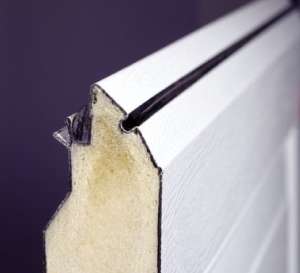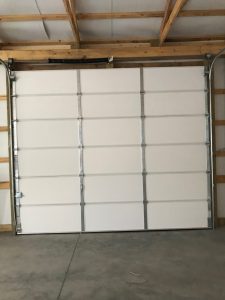Continuing the discussion of high R-values in overhead doors from yesterday’s Part I:
Are reported R-values even accurate?
 There’s another potential problem with R-values reported by garage-door manufacturers: even if one accepts advertised R-values represent center-of-panel values rather than whole-door values, these numbers are still higher than most insulation experts believe are possible.
There’s another potential problem with R-values reported by garage-door manufacturers: even if one accepts advertised R-values represent center-of-panel values rather than whole-door values, these numbers are still higher than most insulation experts believe are possible.
Several manufacturers report their polyurethane-insulated door panels have R-values between R-8.6 and R-9.0 per inch — values highly unlikely if not technically impossible, even for door panel centers.
“The R-value of polyurethane decreases with age,” said Yarbrough. “When it is absolutely fresh you might get R-7.5 per inch, but a realistic aged R-value would be lower — perhaps about R-6.5 per inch would be on the high end. I’m not sure I can explain these reported test results. I have seen labs make mistakes before. I think it’s an error.”
What about air leakage?
If garage-door manufacturers ever decide to report whole-door U-factors or whole-door R-values — an important piece of this door-rating puzzle will still be missing. Why? When it comes to thermal performance of garage doors, air leakage matters much more than R-value.
“Garage doors are so leaky that they are difficult to test,” Thoman said. “Their leaks exceed the capabilities of the available testing apparatus.”
When he needed to buy a garage door for his own house, Thoman ignored advertised R-values. “I find it almost offensive that garage-door manufacturers even publish the R-value of the insulation material,” Thoman told Holladay. “I hate it when I see that, because it’s not a representation of the door’s performance. Air leakage is a much more important issue than the R-value of the door.”
Bottom line
Although some garage-door manufacturers have measured whole-door U-factor and air-leakage characteristics of their doors, most won’t release their data. Until they do, purchasers of garage doors have to select their doors based on anecdotes.
Unfortunately, Sectional Garage Doors can’t be installed air tight, there needs to be room for door to slide up and down against door jambs. These little spaces let cold air draft in and negate much insulating done in door construction.
Some drafts can be stopped with a vinyl weather seal around door and bottom seal, or astragal, can fill in spaces along door bottom depending on how level and even floor is.
Back to why your barndominium needs an insulated overhead door.
More insulation, of course. An uninsulated overhead door is barely a step above an open hole in your wall.
A stronger, more rigid door. Both polystyrene sandwich doors and polyurethane doors are bonded to steel skin to make them stronger. They hold up to better to moderate abuse. Be realistic, there is no door which will hold up to a vehicle bumper.
They are much quieter. This bonding eliminates most rattling which comes with pan (uninsulated steel) doors or as they are referred to as ‘Beer Can Doors”.
And, while you are at it, make sure your insulated overhead door is appropriately wind load rated: http://www.hansenpolebuildings.com/2014/12/wind-load-rated-garage-doors/.
 R-values claimed by garage-door manufacturers are measured at door panel centers. Apparently no manufacturer reports R-value of their entire door panel (including panel edges, seams between panels, and door perimeter) in their promotional materials. Moreover, manufacturers’ reported R-values tell us nothing about air leakage.
R-values claimed by garage-door manufacturers are measured at door panel centers. Apparently no manufacturer reports R-value of their entire door panel (including panel edges, seams between panels, and door perimeter) in their promotional materials. Moreover, manufacturers’ reported R-values tell us nothing about air leakage.





